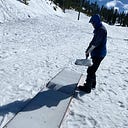Mastering Tree Runs: Safety and Techniques for Snowboarding Through the Woods
Tree runs are among the most exhilarating experiences a snowboarder can have. Carving through a forest offers a unique combination of challenge, beauty, and solitude. However, navigating tree runs requires a blend of skill, strategy, and caution to ensure a safe and enjoyable ride. Whether you’re a seasoned rider or tackling tree runs for the first time, here are some essential safety tips and techniques to master snowboarding through the woods.
Why Tree Runs?
Riding through the trees offers soft snow, protection from wind, and a chance to escape crowded slopes. It’s an opportunity to experience the mountain in its raw, untouched form. However, the tight spaces and natural obstacles make it one of the most technical aspects of snowboarding.
Safety First: Essential Precautions
1. Ride with a Buddy
Tree runs are unpredictable, with hidden obstacles and variable terrain. Always ride with at least one partner and maintain visual or verbal contact. Having someone nearby can be life-saving in case of an accident.
2. Wear a Helmet
Tree runs are notorious for their risk of collisions. A well-fitted helmet protects your head from impacts with trees, branches, or hidden rocks.
3. Carry Safety Gear
Avalanche beacons, probes, and shovels are critical if you’re riding in backcountry tree areas. Additionally, carry a whistle to signal for help if needed.
4. Assess the Terrain
Before entering a tree run, take a moment to scout the area. Look for potential hazards like fallen branches, exposed roots, or steep drop-offs.
5. Stay Visible
Bright-colored clothing makes it easier for your companions to spot you amidst the dense forest. Reflective gear or accessories can also enhance visibility.
Techniques for Tackling Tree Runs
1. Keep Your Eyes on the Openings
Focus on where you want to go, not on the trees you want to avoid. Your body naturally follows your line of sight, so looking at the gaps will guide you smoothly through the run.
2. Maintain a Controlled Speed
Tree runs demand quick reactions. Ride at a speed that allows you to maneuver safely around obstacles. Use short, controlled turns to maintain balance and control.
3. Adopt an Athletic Stance
Keep your knees bent, shoulders relaxed, and your weight centered. This stance helps absorb bumps and allows for quicker adjustments.
4. Use Your Edges Wisely
Snow in tree runs can be uneven, ranging from packed powder to icy patches. Engage your edges for stability, but avoid digging them too deeply, as this can cause abrupt stops or falls.
5. Plan Your Line
Before dropping in, identify a clear route with natural flow. Adjust as needed, but having an initial plan reduces hesitation and improves your confidence.
Common Mistakes to Avoid
– Overconfidence
Even experienced riders can underestimate the challenges of tree runs. Approach each line with respect for the terrain.
– Riding Too Close
Maintain a safe distance from your partner to avoid collisions. This spacing also ensures you have room to adjust your line if needed.
– Ignoring Fatigue
Tree runs are physically demanding. Fatigue can lead to mistakes, so take breaks as needed to stay sharp and focused.
Conclusion
Mastering tree runs combines the thrill of snowboarding with the serenity of nature. By prioritizing safety, honing your techniques, and respecting the terrain, you can elevate your riding experience and explore new aspects of the mountain. Remember, tree runs are as much about precision and control as they are about enjoying the adventure. With the right preparation and mindset, you’ll glide through the woods with confidence and style.
Originally posted on http://shawnboday.net/
